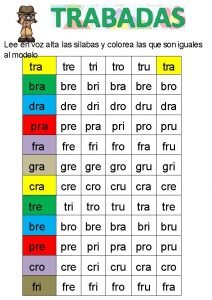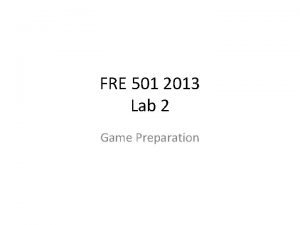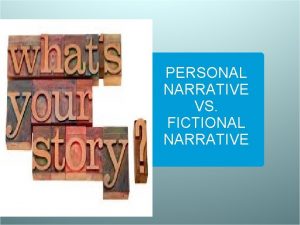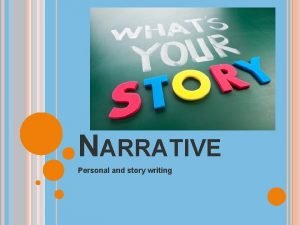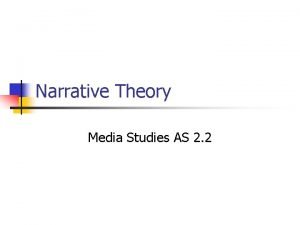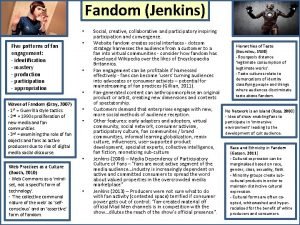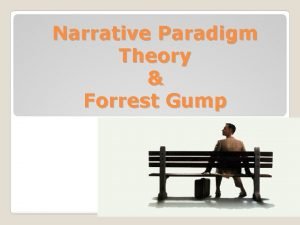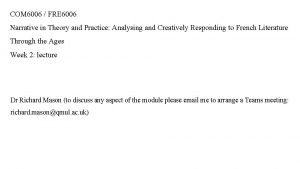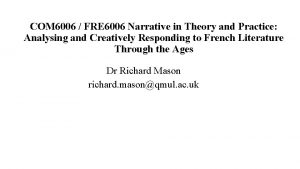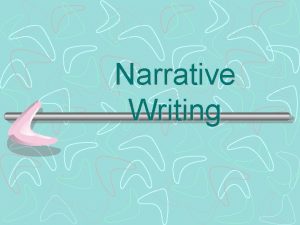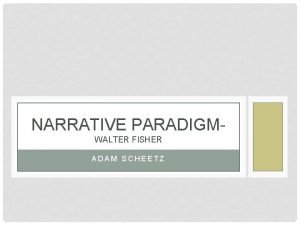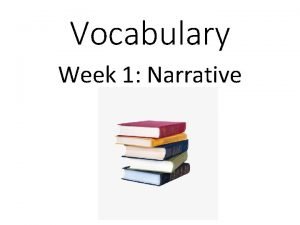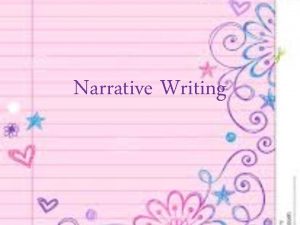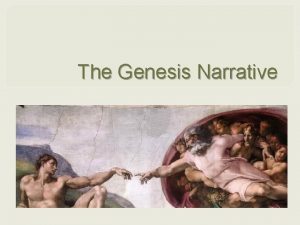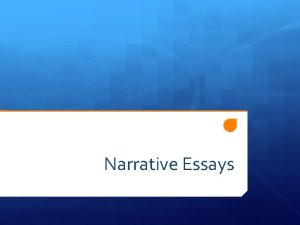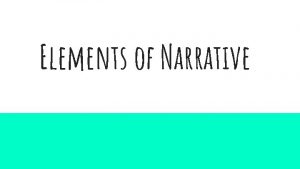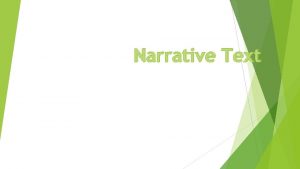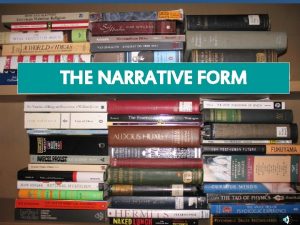COM 6006 FRE 6006 Narrative in Theory and















- Slides: 15

COM 6006 / FRE 6006 Narrative in Theory and Practice: Analysing and Creatively Responding to French Literature Through the Ages Dr Richard Mason richard. mason@qmul. ac. uk

Week 4. ‘Text’: time, characterization, focalization Objectives • Reflect on last week’s laisses similaires • Consider the narratological categories of ‘text’, ‘time’, ‘characterization’ and ‘focalization’ • Put these into practice through close readings of an extract from La Chanson de Roland (The Song of Roland) • Prepare for the narratological analysis (Assignment 1)

‘Text’ ‘Whereas ‘story’ is a succession of events, ‘text’ is a spoken or written discourse which undertakes their telling. Put more simply, the text is what we read. In it, the events do not necessarily appear in chronological order, the characteristics of the participants are dispersed throughout, and all the items of the narrative content are filtered through some prism or perspective. ’ (Rimmon Kenan 2002: 3)

Time: ‘textual arrangement of the event component of the story’ (Rimmon Kenan 2002: 43) • ‘Text time’ always involves a manipulation of ‘story time’ (i. e. there is no ‘pure’ text time) • Important terminology: • diegesis (diégèse) • homodiegetic (same story topic) • heterodiegetic (different story topic)

Time Manipulations of time can be classified according to three basic categories, which Rimmon Kenan takes from Genette: • Order concerns ‘the relations between the succession of events in the story and their linear disposition in the text. ’ • Duration concerns the ‘relations between the time the events are supposed to have taken to occur and the amount of text devoted to their narration. ’ • Frequency concerns ‘the relations between the number of times an event appears in the story and the number of times it is narrated in the event. ’ (Rimmon Kenan 2002: 46)

Time: order Discrepancies of order, or anachronies: • Analepsis (flashback): b, c, a, where ‘a’ is analeptic • Very common, often signalled by pluperfect tense: ‘Prior to her final year at university, Clare had studied in France’. • Prolepsis (foreshadowing, flashforward): c, a, b, where c is proleptic. • ‘[King Marsilie] cannot prevent disaster overtaking him’ (Roland, line 9) • Prolepsis replaces ‘what is going to happen? ’ with ‘how is it going to happen? ’ • Anachronies can be homo- or heterodiegetic (refer within or outside of the immediate world of the story), and external or internal in relation to starting point of ‘first narrative’. • What is the ‘first narrative’ of Roland? Room for debate on this.

Time: duration How do we measure time in a text? Can ‘time’ even to be said to exist at the level of text? • ‘it is much more difficult to describe in parallel terms the duration of the text and that of the story, for the simple reason that there is no way of measuring text duration. ’ (Rimmon Kenan 2002: 52) • ‘The relations in question, are, in fact, not between two ‘durations’ but between duration in the story (measured in minutes, hours, days, months, years) and the length of text devoted to it (in lines and pages), i. e. a temporal spatial relationship. The measure yielded by this relation in general is pace (or speed)’ (Rimmon Kenan 2002: 52– 53) • ‘Taking constant pace as a ‘norm’, we can discern two forms of modification: acceleration and deceleration. ’ (Rimmon Kenan: 53) • ‘scene pace’ (notional convergence of story time and text time, of which dialogue would be the ‘purest’ form) and ‘summary pace’(acceleration, condensation).

Time: frequency Frequency is ‘the relation between the number of times an event appears in the story and the number of times it is narrated (or mentioned) in the text’ (Rimmon Kenan 2002: 57) • ‘singulative’ (narrating n times what ‘happened’ n times) • ‘repetitive’ (narrating n times what happened once) • ‘iterative’ (narrating once what happened n times)

Characterization as the ‘representation in the text of the character component of the story’ (Rimmon Kenan 2002: 43) • ‘There are two basic types of textual indicators of character: direct definition and indirect presentation. ’ (Rimmon Kenan 2002: 60) • ‘A presentation is indirect when rather than mentioning a trait, it displays and exemplifies it in various ways. ’ (Rimmon Kenan 2002: 61) Examples include: action, speech, external appearance, environment

Focalization concerns the ‘angle of vision through which the story is filtered in the text’ (Rimmon Kenan 2002: 43) • Who speaks? vs. Who sees? • i. e. narrative perspective and narration are not the same thing: ‘speaking and seeing, narration and focalization, may, but need not, be attributed to the same agent. ’ (Rimmon Kenan 2002: 73) • ‘[Genette’s notion of focalization] has the great advantage of dispelling the confusion between perspective and narration which often occurs when “point of view” or similar terms are used. ’ (Rimmon Kenan 2002: 72)

Focalization • ‘focalization has both a subject and an object. The subject (the ‘focalizer’) is the agent whose perception orients the presentation, whereas the object (the focalized’) is what the focalizer perceives. ’ (Rimmon Kenan 2002: 75) • focalization can be either internal or external to the narrated events (Rimmon Kenan 2002: 75 76) • The ‘focalized’ can be presented from without (outward appearances and actions) or from within (penetrating thoughts and feelings) (Rimmon

Focalization Different facets of focalization include: • Perception of space (bird’s eye vs. limited observer; external focalization can offer panorama and simultaneity) • Time: an external focalizer has access to different temporalities within the story, whereas an internal focalizer limited to the present of the characters • Cognitive aspect: limited knowledge and omniscience • Emotive component: degree to which focalization is coloured by emotions of characters; ideological facet

Assignment 1: 1500 word narratological analysis (40%): due 23: 55 14 March Write a narratological analysis of one of the following passages. References are to the prescribed editions in each case: 1. La Chanson de Roland/The Song of Roland, lines 1940– 2023 Or 2. La Chanson de Roland/The Song of Roland, lines 2297– 2396 Or 3. La Princesse de Clèves, pp. 177 – 79, ‘Après qu’on eut envoyé [. . . ] la fausse lettre du Vidame. ’/The Princesse de Clèves, pp. 90 92, ‘After the letter [. . . ] false letter had been. ’ Or 4. La Princesse de Clèves, pp. 244– 46, ‘Je veux vous parler encore [. . . ] n’en sortir jamais. ’ / The Princesse de Clèves, pp. 148– 50, ‘I feel I must speak [. . . ] never to abandon it. ’ For ease of reference, line numbered versions of these passages are available as pdfs, from the 'Assignments' section of the module page. You are strongly advised to refer to these versions in your answer: line references will save you a great deal of space. Passages are supplied in both French and English versions. COM 6006 students should analyse and quote from the English version in their answers. FRE 6006 students should

Narratological analysis: how might we analyse the Roland at the level of ‘text’? Form three groups for an analysis of laisses 88– 91; take careful notes in preparation for contributions to the wiki. • Group 1. What is the relation between ‘text time’ and a notional ‘story time’ or linear chronology, and what effect does this have on the presentation of events in this passage? • Group 2. Which techniques of characterization are used in this passage, and to what effect? • Group 3. What techniques of focalization are deployed in the text, and to what

For next week • Nominate one group member to contribute notes to the wiki. • Finish reading La Princesse de Clèves • Assignment 1 task will be made available on Friday (submission deadline Sunday 10 November).
 Protein sentezini sonlandıran kodonlar
Protein sentezini sonlandıran kodonlar Dậy thổi cơm mua thịt cá
Dậy thổi cơm mua thịt cá Cơm
Cơm Palabras con dru
Palabras con dru Ubc canvs
Ubc canvs Personal narrative vs short story
Personal narrative vs short story Personal narrative vs fictional narrative
Personal narrative vs fictional narrative Freytag's narrative theory
Freytag's narrative theory Binary opposition example
Binary opposition example Story convention
Story convention Todorov narrative theory
Todorov narrative theory Henry jenkins fandom theory
Henry jenkins fandom theory Forrest gump theories
Forrest gump theories Trait theory of leadership
Trait theory of leadership Continental drift vs plate tectonics
Continental drift vs plate tectonics Continental drift vs plate tectonics theory
Continental drift vs plate tectonics theory



